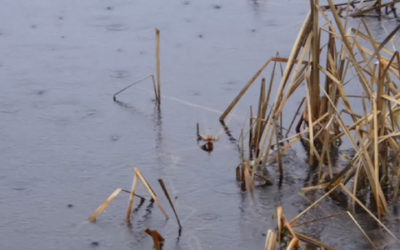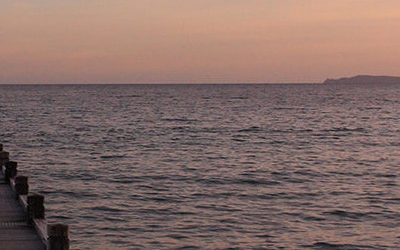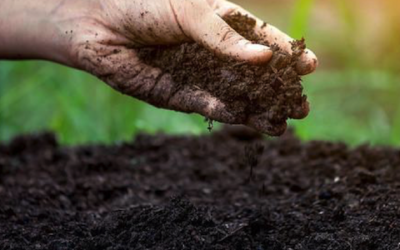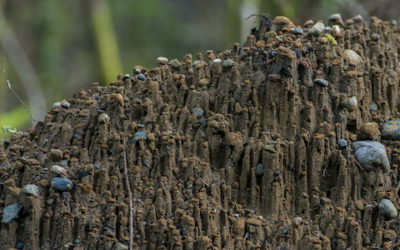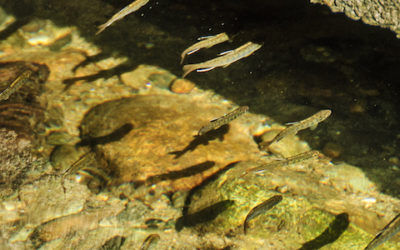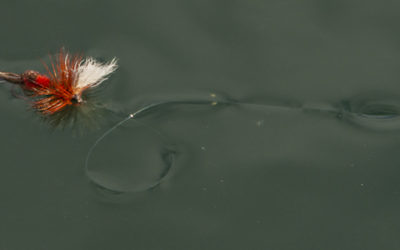SHAPE UP, RAINDROP!
by Amy Roszak, Spring 2019
Photos & video by John F. Williams except where noted
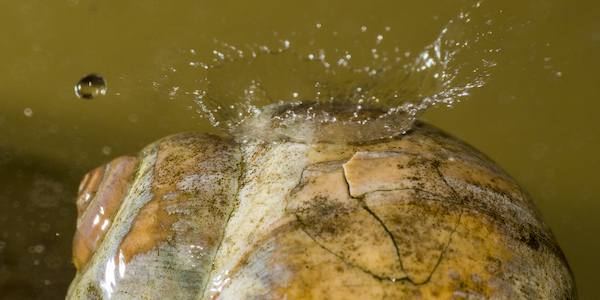
SHAPE UP, RAINDROP!
By Amy Roszak, Summer 2019
Photos & video by John F. Williams except where noted
although most of us think of raindrops as tear shaped,
by the time we see them falling through the sky, they are actually are shaped more like the top half of a hamburger bun with the flat part on the bottom. You see, high up in the atmosphere, droplets start out spherical in shape due to the surface tension of water, but then other forces like gravity, air resistance come into play. If this is starting to sound too geeky, please don’t go! Soon enough we’ll be talking about Water Strider bugs, hot soup, and melting icicles. And when your inner scientist starts to emerge, I’ve got some intriguing 30-Second Water Surface Tension Explorations you can try.

Drop image from slow motion movie courtesy of Alan Teitel at youtube.com/user/ultraslo
So back to that spherical drop which is bouncing around in the upper atmosphere. It starts out small, bumping into and merging with other little droplets, all being kept afloat because of upward moving air masses. When those droplets finally merge into a drop large enough, the earth’s gravitational force overcomes the forces that were keeping it airborne, and the drop begins to fall faster and faster toward us. Although all objects fall at the same rate in a vacuum (like on the moon), air resistance on earth acts to slow falling things down. It’s air resistance at work when parachuters (thankfully) fall much, much more slowly after their chutes open. That same air resistance causes smaller raindrops, with their greater ratios of surface area to their mass, to mostly fall slower than larger raindrops.
 For more about what happens when the raindrop hits earth, see Pedestal Erosion in this issue.
For more about what happens when the raindrop hits earth, see Pedestal Erosion in this issue.

Image from USGS, public domain
let’s ponder these questions to see what we already know about volume and surface area, and connect it to the shape of a raindrop.
Question #1
Which container of hot soup stays hotter longer, and why?

a. Large, deep tureen or crock
b. Large shallow serving bowl
Answer a: The deep bowl has less surface area exposed to surrounding cold air so the center of the soup retains its heat.
Question #2
Given 100’ of fencing to enclose a four sided pasture, what shape would provide the larger space?
a. A square with 25’ on each side.
b. A rectangle that is 45’ by 5’
Answer a: 100’ of fencing encloses 625 sq ft in the square which is much bigger than the 225 sq. feet of pasture enclosed in the rectangle. If you build a circle with the same amount of fencing, you’d get almost 800 sq feet of pasture!
If you’re wondering what the Water Strider has to do with the shape of a raindrop, we need to discuss the really important concept of the surface tension of water. (No aspirin needed for this kind of tension luckily!) Surface Tension is roughly explained as the tendency of the surface of a fluid to shrink and compact the liquid, leaving the minimum amount of exposed surface area as possible.
Hopefully you are able to make the connection from our pasture discussion: just like the circle is the 2-dimensional shape with the greatest area for a given perimeter, the sphere is the 3-dimensional shape with the greatest volume for a given amount of surface area. Since surface tension shrinks a drop of water into the 3-dimensional shape with the minimum exposed surface area possible, it would make sense that (barring any further complications) our drop of water should be spherical, not tear shaped. And this is, in fact, how it starts off.

But of course, there are further complications. While the drop starts out as a sphere, that original spherical droplet morphs into the “hamburger upper bun” shape when the underside of the drop faces wind resistance head-on (or rather “bottom-on) causing it to flatten.
Image from NASA. See “Shape of Raindrop” in Find Out More.
entertain your friends and family later with these 30-second water surface tension explorations…but think about them now

Make a compass by rubbing a fridge magnet 20 times on a sewing needle in the same direction. Gently set the needle on top of the water (tweezers help). Watch the floating needle turn to face North.
Put water onto a penny and let it rise higher than the edge without overflowing.
P.S. Try an eyedropper
P.P.S. Which holds more water, heads or tails?
After it rains, investigate the shape of the drops of water beading on leaves.
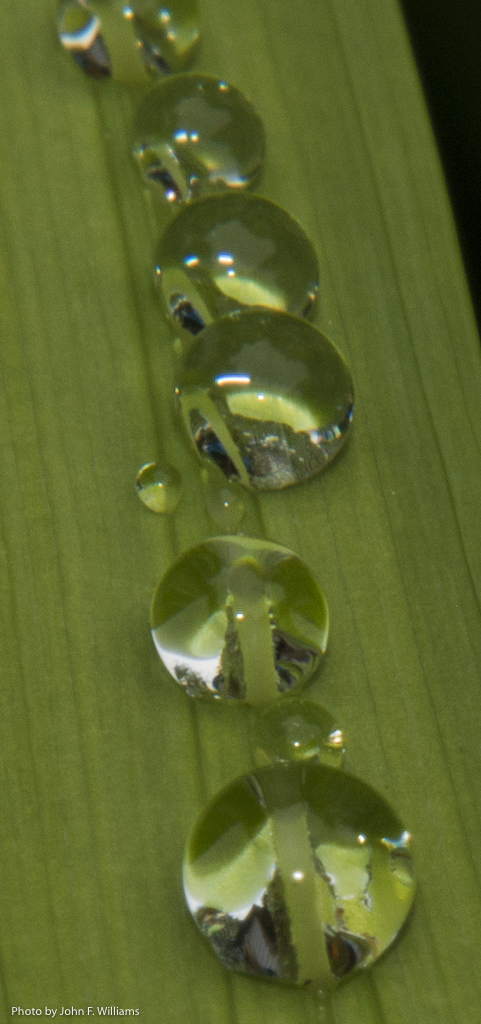
Touch the water in a glass and watch the water stick to your finger. Slowly raise your finger and watch the water column grow taller and thinner, until it finally breaks.
back to our discussion of surface tension ….

If you made the connection that surface tension is responsible for keeping the Water Strider’s six little feet from falling through the surface of the pond or stream, give yourself a gold star and a drink of water. However, the cohesive forces are only so strong, and while strong enough to hold up the weight of a little bug, they are not strong for you to walk on water.
So now we have determined that surface tension is responsible for compacting the molecules of water, that the spherical shape is the most geometrically compact, and that gravity and frictional air current resistance are responsible for the deformation of the sphere into a hamburger bun shape.
is it time to go for a walk in the rain?
Not so fast. IF raindrops ARE spherical until they are deformed into a hamburger top bun shape by gravity, friction, and air currents, how come we DO actually see typical “tear drop” shaped water droplets dripping from a sink faucet (get the washer replaced) or melting from icicles?
This, too, is because of both surface tension and gravity. Think about a drop which begins as a very small round bead, which gradually gets bigger and bigger as more water accumulates. All the time, gravity is working to pull the drop downwards, stretching it ever longer while the force of surface tension is keeping it from falling, until it finally gets too big and heavy and… it breaks free! It’s before it breaks away that we are able to clearly see it; this is when the drop looks tear shaped.


Images from movie referenced below by Alan Teitel
When the separation actually occurs and the water droplet breaks free on its relatively quick solo ride downward, the surface tension has once again pinched the water droplet into a spherical shape although it’s moving much too fast for us to see that the actual shape of the water droplet wiggles to find equilibrium in a spherical shape. The row of photos above is from a slow motion video Alan Teitel filmed of this process.
He also filmed rain in slow motion, and since rain is the theme of this issue of Salish Magazine, I suggest that you take a look!

Amy Roszak, after moving west from NYC to earn her MS at Oregon State in 1980, was a USFS Hydrologist, Award-winning mathematics teacher, stay-at-home mom, and inventor. She received her first patent solving the challenges of printing on vellum when scrapbooking her toddlers’ lives, founding ScraPerfect. Since her move in 2008 to Kitsap County, WA, she has been an avid volunteer as a Stream Steward, Beach Naturalist, Salmon Docent, Emergency Cold-weather Shelter Volunteer and tutor at the local Immigrant Assistance Center, to name a few. She loves learning about pretty much anything, and is usually up for a challenge. (“Thanks John Williams, for the request and opportunity to delve into the shape of raindrops!”)
Table of Contents, Issue #3, Spring 2019
Precipitation
by Leigh Calvez, Spring 2019 Photos & video by John F. Williams except where notedBy Leigh Calvez, Summer 2019 Photos & video by John F. Williams except where notedas a transplanted midwesterner, i am fascinated by the precipitation here in the pacific...
Poems-3
Jenifer Browne Lawrence is the author of Grayling (Perugia Press, 2015), and One Hundred Steps from Shore (Blue Begonia Press, 2006). Awards include the Perugia Press Prize, the Orlando Poetry Prize, the James Hearst Poetry Prize, the Potomac Review poetry award, and...
Rainbow
Rain Gardens Help Rain Find Clean Paths to the Sea by Sharon Pegany Photos & video by John F. Williams except where notedRain Gardens Help Rain Find Clean Paths to the Sea By Sharon Pegany, Spring 2019 Photos & video by John F. Williams except where...
Soil
Partners in Sustaining Life by Sharon Pegany, Spring 2019 Photos & video by John F. Williams except where notedUSDA Public DomainUSDA Public DomainPartners in Sustaining Life By Sharon Pegany, Summer 2019 Photos & video by John F. Williams except where...
Soil Pedestals
by Greg Geehan, Spring 2019 Photos & video by John F. Williams except where notedEarly Indicators of Erosion By Greg Geehan, Summer 2019 Photos & video by John F. Williams except where notedwhat does the rain hit?Rain nurtures Salish forests, and the forest...
Coho
by Paul Pegany, Spring 2019 Photos & video by John F. Williams except where noted By Paul Pegany, Summer 2019 Photos & video by John F. Williams except where noted can rain gardens help save salish sea coho salmon?The answer is a definite…maybe. One hidden...
Currency
by Ron Hirschi, Spring 2019 Photos & video by John F. Williams except where notedBy Ron Hirschi, Summer 2019 Photos & video by John F. Williams except where notedKITSAP COUNTY SUPPORTS A FAIR NUMBER OF YEAR-ROUND STREAMSUnlike most other western Washington...
FIND OUT MORE
NASA, Precipitation Education, The Shape of a Raindrop
Teitel, Alan, Icicle drip in UltraSlo motion
Teitel, Alan. Rain drops in UltraSlow.
Teitel, Alan, Water drops in slow motion Eye Candy!. UntraSlo is a collection of Alan’s slow motion videos
USGS, Surface Tension Allows a Water Strider to Walk on Water

